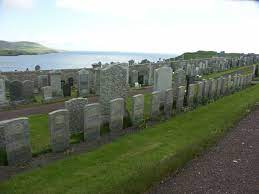Horace Cecil Cartlidge
Date of birth: 17.12.1919
Date of death: 09.12.1941
Area: Knottingley
Regiment: West Yorkshire (Prince of Wales’s Own)
Family information: Son of Sydney and Clara Cartlidge (nee Booth)
Rank: Lance Sergeant
Service number: 4542130
War Service
Horace Cecil Cartlidge enlisted on 18th April 1940 and was posted to Commando Troop at Scarborough in the Special Service Battalion.
When he died, on 9th December 1941, he was in 6 Commando Prince of Wales’s Own (West Yorkshire Regiment) and was buried at Lerwick.
OPERATION KITBAG
The National Archives DEFE 2/343 No. 98/003 - British Policy and Strategy Towards Norway:
“The original purpose of the Commandos was to restore the offensive spirit in the British Army and bolster morale. In the light of recent disappointments. Mountbatten wanted ‘Operation Kitbag’ to take place as a divisionary Commando attack on the fish processing plants at Floro to maintain the morale.
Horace Cartlidge must have shown leadership ability for in a short military career of only 20 months he was promoted, though reluctantly, to the rank of Lance Sergeant in an elite troop.
This operation code named ‘Kitbag’ was scheduled for 11th December 1941 and detachments from 6 and 12 Commando, an elite group of soldiers, together with Norwegian soldiers from NIC 1 were selected for this operation to land in Norway and disrupt the German stronghold at Floro, just North of Bergen.
They were on board the ‘HMS Prince Charles’ a troop landing ship, escorted by 4 destroyers. The Commandos embarked on 2nd December 1941 and arrived in Scapa Flow, Orkney Islands the following day where exercises and practice landings were being carried out. The troops were being filmed at this time for propaganda purposes and attracted the attention of large crowds
The expedition set sail again from Scapa Flow on 9th December 1941 to carry out this assault. The need for haste led to the priming of grenades below deck, under artificial light, contrary to standing orders. For some unknown reason, probably tiredness and seasickness, a primed grenade had been placed in the box of unarmed grenades. Inevitably this was picked up by a soldier who removed the pin to clean it before screwing in the fuse. When the grenade started to fizz he showed considerable presence of mind and courage, and in attempt to protect his comrades, ran forward to the emergency hatch whilst still holding the grenade. As he struggled to the doorway he dropped the grenade, and a Norwegian Corporal bent down to pick it up just as it exploded, killing both soldiers instantly, together with two others, one which we now know to have been L/Sgt Cartlidge. As many as 25 others were wounded to various degrees. As an eye witness recalled “the speed with which the whole thing happened, transforming a happy body of men into a shambles, is a thing one cannot ever forget.”
The bodies and wounded were removed that night [presumably at Lerwick on Shetland Isles] and the unfortunate raiders set sail again. They arrived off the coast of Norway on the morning of 12th December, but the operation failed and was abandoned as the entrance to the Fjord at Floro could not be located. The force Commander Captain P Todd RN, aware and anxious for the safety of the ships off a hostile coast, and in broad daylight, decided to abandon the operation.”
The Stories of The Commandos - The British Army Legendary Front page 56 - Robin Hunter 2013:
“Number 6 and 12 Commando sailed from Scapa Flow in December to attack the town of Floss in Norway. This raid was marred by an accident aboard their assault ship HMS Prince Charles, when a primed grenade exploded, killing six men below deck. This raid was accompanied by several press cameramen whose aim was to obtain a record of the operation. They had filmed the usual ship-board scenes - Commando’s exercising, chaps in their hammocks, or writing a last letter home, and it was suggested they should shoot a close up of the final weapon overhaul and grenade priming, on one of the troop decks below.
This was thought a good idea, and the cameras began to roll on a scene of intense activity. A hundred men were cleaning all types of weapons, while at a table six men were busy cleaning the Mills bomb - the No. 36 grenade - passing them to the end man, who put the detonator in. One enterprising cameraman, anxious to get things in focus, pulled a handful of grenades nearer, unnoticed by the men busy with their tasks, and so mixed up the primed and un-primed grenades. The first man picked up the grenade, thinking it un-primed, removed the safety pin and so let the striking lever fall on the base plug. To his horror, a small bang denoted this grenade was primed, and the fuse burning. He shouted and made desperate attempt to haul the grenade through the open hatch on to the deck above.
It was a good and gallant effort, but the grenade hit the hatchway combing and fell back. A Norwegian standing below caught it to haul it out again; too late for the 4 second delay was up. The grenade exploded just opposite his chest, killing six men outright, and injuring eleven others. The speed with which it happened transforming a happy body of men into a shambles is a thing one cannot easily describe, but chaos sums it up. Morale on board fell further when the Naval Commander was unable to fix his position, and in the end the raid was abandoned.”
Family Life
Horace Cecil Cartlidge was born on 17th December 1919, the son of Sydney, a Potter and Clara (nee Booth). They had married on 1st June 1914 at St Andrew’s Church, Ferrybridge. They resided at 6, Vale Terrace, Ferrybridge.
 Lerwick Cemetery
Lerwick Cemetery

